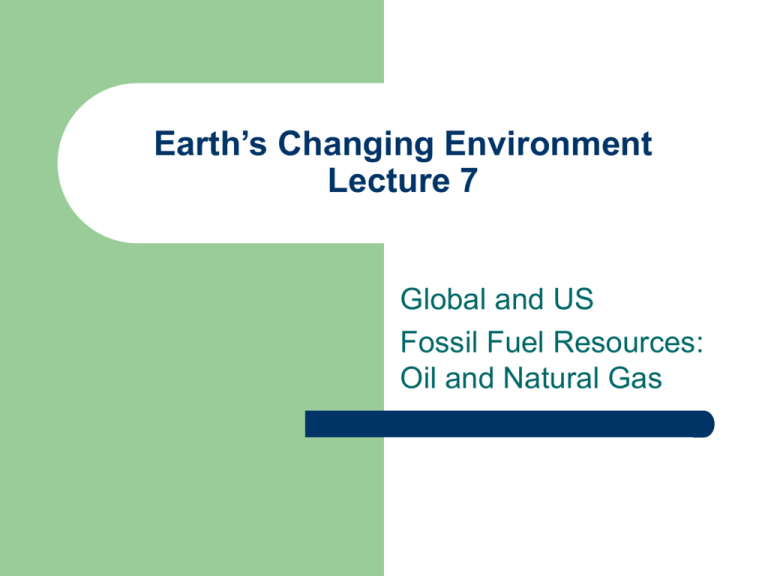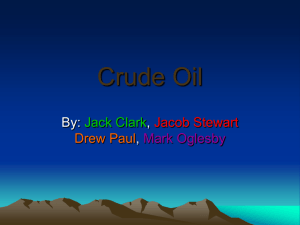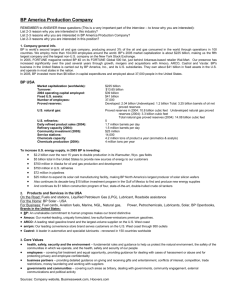Global and US Oil and Natural Gas Resources
advertisement

Earth’s Changing Environment Lecture 7 Global and US Fossil Fuel Resources: Oil and Natural Gas Fossil Fuels Formed 50 million to 350 million years ago from plants and animals. Fuels • • • • • Petroleum Natural Gas Coal Shale Oil Tar Sands US Energy Consumption (QBtu) Petroleum 38 (39%) Natural Gas 23 (24%) Oil and Natural Gas Oil Hydrocarbon chains CH2-CH2- CH2---- 2CH2 + 3O2 2CO2 + 2H2O Natural Gas Primarily Methane CH4 CH4 + 2O2 2H2O + CO2 Oil Crude oil is measured in barrels. A 42-U.S. gallon barrel of crude oil provides slightly more than 44 gallons of petroleum products. Oil Refinery After crude oil is removed from the ground, it is sent to a refinery The crude oil is separated into useable petroleum products. Oil Refinery A 42-U.S. gallon barrel of crude oil provides slightly more than 44 gallons of petroleum products. One barrel of crude oil, when refined, produces 20 gallons of finished motor gasoline. Petroleum Products Gasoline Prices Natural Gas Natural gas prices have fluctuated because of variable supply. New pipelines from Alaska may solve some of this problem. Reserves and Resources Reserves are known sources that are extractable with current technologies at current prices. Resources include sources not currently being exploited because of cost and sources not yet discovered. Oil and Gas Units Gbo billion barrels of oil. G stands for Giga. Used for global and US oil resources TCF trillion cubic feet. Used for global and US natural gas resources. Example Problem 1 US annual oil consumption equals 7.2 Gbo. Express this value in millions of barrels per day. US Oil consumption = 7.2x109 bbl/ 365 days = 20 million bbl/day (11 million bbl day imported) Global Oil and Gas Reserves, Resources, Consumption Oil • • • Reserves 1,000 Gbo Resources 1,700 Gbo Consumption 28 Gbo Natural Gas • • • Reserves 5,500 TCF Resources 10,000 TCF Consumption 90 TCF US Oil and Gas Reserves, Resources, Consumption Oil • • • Reserves 22 Gbo Resources 98 Gbo Consumption 7.2 Gbo Natural Gas • • • Reserves 180 TCF Resources 710 TCF Consumption 23 TCF Global Oil Resources • • • • • • • • • • • • Saudi Arabia Iraq Iran Kuwait UAE Russia Venezuela Nigeria Libya China Mexico United States 26% 11% 10% 10% 6% 5% 5% 3% 3% 3% 2% 2% Global Oil Production • • • • • • • • • Saudi Arabia United States Russia Iran Mexico Norway China Venezuela Canada 12% 11% 10% 5% 5% 5% 4% 4% 4% Global Natural Gas Resources • • • • • • • • • • Russia Iran Qatar Saudi Arabia UAE United States Algeria Nigeria Venezuela Iraq 29% 16% 13% 4% 3% 3% 3% 3% 3% 2% Global Natural Gas Production • • • • • • • Russia 23% United States 22% Canada 7% United Kingdom 4% Algeria 3% Netherlands 3% Indonesia 3% Example Problem 2 Assuming constant level of consumption, estimate the lifetime of US oil resources Lifetime = 98 Gbo / 7.2 Gbo/year = 14 years Assuming constant level of consumption, estimate the lifetime of global oil resources Lifetime = 1700 Gbo / 28 Gbo/year = 60 years What is wrong with these assumptions? When will worldwide conventional oil production peak? US Production Peaked in 1970 Lower 48 Crude Oil Reserves & Production, 1945-2000 Crude Oil Reserves, Billion Barrels 35 Peak Reserves 1959 4.0 Peak Production 1970 3.5 30 3.0 25 2.5 20 2.0 15 1.5 10 5 0 1945 1950 1955 1960 1965 1970 1975 1980 Lower 48 Reserves 1.0 Lower 48 Production 0.5 1985 1990 1995 0.0 2000 Crude Oil Annual Production, Billion Barrels 40 Published Estimates of World Oil Ultimate Recovery USGS 5% 2000 USGS Mean 2000 USGS 95% 2000 Campbell 1995 Masters 1994 Campbell 1992 Bookout 1989 Masters 1987 Martin 1984 Nehring 1982 Halbouty 1981 Meyerhoff 1979 Nehring 1978 Nelson 1977 Folinsbee 1976 Adams & Kirby 1975 Linden 1973 Moody 1972 Moody 1970 Shell 1968 Weeks 1959 MacNaughton 1953 Weeks 1948 Pratt 1942 0 0.5 Source: USGS and Colin Campbell 1 1.5 2 2.5 Trillions of Barrels 3 3.5 4 Different Interpretations of a Hypothetical 6,000 Billion Barrel World Original Oil-in-Place Resource Base 6,000 5,000 4,200 Billion Unrecovered 3,000 Billion Unrecovered Unrecoverable Reserves Growth Undiscovered 4,000 3,000 Reserves Growth Adds 10% 2,000 50% Recovery Factor with Reserves Growth 40% Recovery Factor Without Reserves Growth 1,000 Proved Reserves Cumulative Production 30% Recovery Factor 0 USGS Approach 1995 Campbell/Laherrere Approach Campbell-Laherrère World Oil Production Estimates, 1930-2050 Production Peak 2004 Campbell Annual Production Scenarios with 2 Percent Growth Rates and Different Decline Methods 60 USGS Estimates of Ultimate Recovery History 2037 Billion Barrels per Year 50 40 Ultimate Recovery Probability BBls ---------------------------Low (95 %) 2,248 Mean (expected value) 3,003 High (5 %) 3,896 Mean w/ 2% Growth and 2% Decline Mean w/ 2% Growth and 10 R/P Ratio Decline 2016 2% Growth & 10 R/P Ratio Decline 30 2% Growth & 2% Decline 20 10 0 1900 1925 1950 1975 2000 2025 2050 Note: U.S. volumes were added to the USGS foreign volumes to obtain world totals. 2075 2100 2125 Annual Production Scenarios with 2 Percent Growth Rates and Different Resource Levels (Decline R/P = 10) 70 USGS Estimates of Ultimate Recovery Billion Barrels per Year 60 50 40 2047 Ultimate Recovery Probability BBls ---------------------------Low (95 %) 2,248 Mean (expected value) 3,003 High (5 %) 3,896 2% Growth 2037 2026 Decline R/P = 10 30 20 10 0 1900 History Mean Low (95 %) High (5 %) 1925 1950 1975 2000 2025 2050 2075 Note: U.S. volumes were added to the USGS foreign volumes to obtain world totals. 2100 2125 Annual Production Scenarios for the Mean Resource Estimate and Different Growth Rates (Decline R/P = 10) 70 USGS Estimates of Ultimate Recovery 2030 @ 3% Growth Billion Barrels per Year 60 50 Ultimate Recovery Probability BBls ---------------------------Low (95 %) 2,248 Mean (expected value) 3,003 High (5 %) 3,896 2037 @ 2% Growth 2050 @ 1% Growth 40 30 Decline R/P = 10 20 History 10 0 1900 Mean 1925 1950 1975 2000 2025 2050 Note: U.S. volumes were added to the USGS foreign volumes to obtain world totals. 2075 2100 2125 Annual Production Scenarios for the Mean Resource Estimate Showing Sharp and Rounded Peaks 60 Billion Barrels per Year 50 40 USGS Estimates of Ultimate Recovery Peak in 2037 Decline @ R/P = 10 Ultimate Recovery Probability BBls ---------------------------Low (95 %) 2,248 Mean (expected value) 3,003 High (5 %) 3,896 30 Peak in 2030 Decline @ 5 % 2% Growth 20 History 10 0 1900 Mean 1925 1950 1975 2000 2025 2050 Note: U.S. volumes were added to the USGS foreign volumes to obtain world totals. 2075 2100 2125 When will Global Oil Production Peak? Difficult to predict. Depends on geology and economics. Best estimates are sometime between 2004 and 2050.





